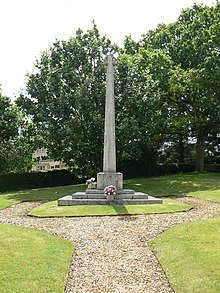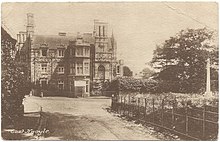East Knoyle War Memorial
| East Knoyle War Memorial | |
|---|---|
| United Kingdom | |
 | |
| For soldiers from East Knoyle killed in war | |
| Unveiled | 1920 |
| Location | 51°04′26.9″N 02°10′14.4″W / 51.074139°N 2.170667°W |
| Designed by | Herbert Maryon |
Listed Building – Grade II | |
| Official name | East Knoyle War Memorial |
| Designated | 4 October 2016 |
| Reference no. | 1438366 |
The East Knoyle War Memorial is a monument that commemorates the lives of soldiers from East Knoyle, Wiltshire, England, who were killed in war. Unveiled on 26 September 1920, it was originally intended to commemorate the 20 soldiers from the parish who died during the First World War. Subsequent inscriptions were added to recognise twelve who were killed in the Second World War, and a soldier killed by friendly fire in Iraq in 2003. In 2016 the memorial designated a Grade II listed building.
The memorial was designed by Herbert Maryon, who taught sculpture at the University of Reading. It consists of a three-stepped stone base, a square plinth, and a shaft that rises 16 feet (4.9 m) and terminates in a small wheel cross. Each side of the plinth is inscribed. The front bears an inscription dedicated to those who died in the world wars; each is named on the right and rear. The left panel includes a bible verse and the name of the soldier who died in the Iraq War.
Background
In the aftermath of the First World War and its unprecedented casualties, thousands of war memorials were built across Britain. Virtually every village, town, or city erected some form of memorial to commemorate their dead. In East Knoyle, the effects of the war were particularly acute.[1] At least 20 of the 853 people who lived in the village before the war died during it,[note 1] including three brothers from one family.[1][3]
Even many of those who survived did not return, facing diminished opportunities at home, and by 1918 the village had only 650 residents.[1][4] Technological advances precipitated the end of the agrarian economy, and, like many other towns, East Knoyle faced the decline of its principle families, which before the war had tended estates employing much of the town.[5][4] Even before the war, the Seymour family's influence in East Knoyle had been waning.[6] The further declines afterwards may have owed to increased estate taxes, or simply the absence of a new generation to take the place of the last;[5][7] shortly before her own death in 1920 the matriarch of the Wydham family, which controlled the Clouds estate, commissioned a plaque for St. Mary's Church commemorating the five grandsons she had lost in the war.[8]
Commissioning
A memorial committee was tasked with raising funds for a memorial and for additions to the town hall, to serve as a community centre.[9] Chaired by Colonel Guy Wyndham, the committee had the Hon. George Herbert as its honorary secretary,[note 2] and was assisted by a Mr. F. W. Barnes.[9] Ultimately, £1,450 was raised for the cause: £1,000 from the trustees of the Seymour estate, and £450 through subscription.[9]
The architect chosen to design the memorial was Herbert Maryon,[9] who taught sculpture, including metalwork, modelling, and casting, at the University of Reading.[10][11] Maryon had established himself in the Arts and Crafts movement before moving to academia, and in the years following the war designed several memorials. The East Knoyle memorial was among his first; the following year he designed the Mortimer War Memorial, a similar monument in Mortimer Common, Berkshire,[12] and in 1923 he created a plaque for Manchester's Chorlton Road Congregational Church.[13] The University of Reading likewise commissioned him to create their war memorial, which was unveiled in 1924.[14]
Design
The memorial is carved from Portland stone.[15] It comprises a three-stepped square base set beneath a square plinth, from which a thin, tapering shaft rises 16 feet (4.9 m) and terminates in a small wheel cross.[15] Two stone flower holders rest on the top step, one of which is inscribed "Best kept war memorial 1973".[16]
The four sides of the plinth are each inscribed. The side facing the road bears an inscription commemorating those who died in the First and Second World Wars; their names are listed to its right and rear, respectively. John 15:13 is inscribed to its left, above the name of a soldier who died in the Iraq War.[15]
| Front | Right | Rear | Left |
|---|---|---|---|
| TO·THE·GLORY·OF·GOD AND·IN·MEMORY·OF·THE MEN·OF·THIS·PARISH WHO·MADE·THE·SUPREME SACRIFICE·IN·THE·GREAT WAR·1914·1918·AND·IN THE·WORLD·WAR·1939·1945 |
1914·1918 EDWIN·DURRANT:FRANK·W·KNIGHTGERALD·S·FORWARD:JAMES·J·LAMPARD JAMES·F·FLETCHER:REGD·G·LITTLECOTT WILLIAM·T·FRICKER:OLIVER·SNOOKE ROBERT·GRIFFITHS:EDWARD·D·SMALL ALBERT·J·HARRIS:ERNEST·TANSWELL EDWARD·W·JOLLIFFE:ROBERT·S·TANSWELL FRED·JOLLIFFE:EDGAR·WAREHAM VICTOR·H·JOLLIFFE:GEORGE·WYNDHAM SYDNEY·JUKES:PERCY·L·WYNDHAM |
1939·1945 NIGEL·N·ADAMS : WILLIAM·J·BOLTONR·ALAN·J·DENNIS : E·GEORGE·FLOWER H·JAMES·FORD : ERNEST·H·FRANCIS VICTOR·J·T·HALLETT · GORDON·HART ALASTAIR·HOUGHTON·BROWN : JOHN·A·M·LAREN JACK·D·PEPPER : GEORGE·E·THOMAS |
GREATER·LOVE·HATH·NO MAN·THAN·THIS·THAT·A MAN·LAY·DOWN·HIS·LIFE FOR·HIS·FRIENDS· IRAQ·2003·MATTHEW HULL |
History

The memorial was unveiled on 26 September 1920.[9] Lord Rawlinson officiated, in his last public act before departing to take up the Indian Command.[17] He was received by a guard of honour comprising the Comrades of the Hindon and Knoyle Posts and the Knoyle Girl Guides; the Knoyle Band, conducted by a Mr H Fry, performed as well.[9] Among those in attendance, the Western Gazette reported, included Guy Wyndham, George Herbert, Herbert's mother the Dowager Countess of Pembroke, Dr. Arthur John Jex-Blake and his wife Lady Muriel, Captain Guy Richard Charles Wyndham, Olivia Wyndham, Colonel Henry Bouverie, Rev. Marshall Winder Lumsden,[18] Dr and Mrs J. Blythe, Inspector Townshend, and Herbert Maryon.[9][note 3]
The ceremony began in St Mary's Church and, led by the choir and clergy, proceeded to the memorial.[9] Three clergy—the rector, Rev. W. Neville, and Rev. E. A. Reader—conducted a brief service and Rev. F. Yeomans read a lesson, before Rawlinson removed a Union Jack from the memorial and delivered a speech.[9] Rawlinson read the inscription on the front of the memorial, then noted that he had been brought up in East Knoyle as a child; he recalled a number of people, such as Alfred Seymour, who had since died, and said he had been close friends with one of those being commemorated.[9] Those whose names were engraved had done their duty, Rawlinson said, and the cross was erected as a memorial to their bravery, to record their great deeds, and to perpetuate their memory.[9] Afterwards, the rector dedicated the memorial and led prayers.[9] The hymns When I Survey the Wondrous Cross and There is a Blessed Home were sung, and buglers from the Wiltshire Regiment performed the Last Post.[9] Rawlinson laid a laurel wreath on the memorial and relatives of the dead left flowers.[9] Afterwards, the crowd left for the town hall, where Rawlinson officially opened the new additions.[9]
After the Second World War, and later the Iraq War, additional engravings were added to commemorate the additional dead.[15] Twelve names were added to the rear panel after the Second World War, and the conflict was added to the front.[15] Another name was added after a soldier was killed by friendly fire in Iraq in 2003.[15][19][20]
On 4 October 2016 the memorial was listed as a Grade II building.[15] The listing entry termed the memorial "an eloquent witness to the tragic impact of world events on the local community and the sacrifice it made in the conflicts of the [twentieth and twenty-first centuries]".[15]
Notes
- ^ The war memorial lists 20 names, although subsequent lists have pushed this number as high as 27.[2][3] The 20 named on the memorial were predominantly born and raised in East Knoyle; the additional seven—the brothers Percival Henry and Walter Geoffrey Hill, the brothers James Henry and Tom Samual Lampard, and William George Caddy, William John Clifford, and George Elliott—were born in East Knoyle but raised elsewhere.[3] Some are commemorated by other memorials, such as the brothers Hill, whose names appear on the Donhead St Andrew War Memorial.[3]
- ^ Herbert was the son of Sidney Herbert and the brother of Reginald Herbert, the 14th and 15th Earls of Pembroke, respectively.
- ^ The Western Gazette also recorded Mr E. H. Miles, Mr F. Alford, Mr H. Francis, Mr J. Jones, Mr H. Burton, Mr F. W Barnes, and Mr T. Bath.[9] Others who were not named also attended.[9]
References
- ^ a b c East Knoyle Newsletter 2018, p. 5.
- ^ Wiltshire Footprints.
- ^ a b c d East Knoyle WWI Trail.
- ^ a b East Knoyle & The Great War, pp. 8, 11.
- ^ a b East Knoyle Newsletter 2018.
- ^ East Knoyle & The Great War, p. 11.
- ^ East Knoyle & The Great War, p. 8.
- ^ Wyndham memorial.
- ^ a b c d e f g h i j k l m n o p q Western Gazette 1920.
- ^ Institution of Mechanical Engineers 1918.
- ^ Studies in Conservation 1960.
- ^ Mortimer War Memorial.
- ^ The Builder 1923.
- ^ Historic England Reading.
- ^ a b c d e f g h Historic England East Knoyle.
- ^ East Knoyle Cross.
- ^ Western Gazette 1925.
- ^ Western Gazette 1036.
- ^ Kirby 2003.
- ^ Lyall 2007.
Bibliography
- "Contributors to this Issue: Herbert Maryon". Studies in Conservation. 5 (1). February 1960. JSTOR 1505065.

- "East Knoyle". Wiltshire Footprints. Retrieved 23 March 2020.

- "The East Knoyle 1918 Trail" (PDF). The East Knoyle Newsletter. 44 (3): 5. May–June 2018.

- "East Knoyle – Cross". War Memorials Register. Imperial War Museums. Retrieved 17 March 2020.

- "East Knoyle War Memorial". The Western Gazette. No. 9, 557. Yeovil. 1 October 1920. p. 8.

- East Knoyle & The Great War: 1914–1918. 2018.

- "The East Knoyle WW1 History Trail". East Knoyle. Retrieved 17 March 2020.

- "Five Grandsons of Madeline Wyndham". War Memorials Register. Imperial War Museums. Retrieved 17 March 2020.

- Kirby, Terry (16 April 2003). "For Queen and Country". The Independent. Retrieved 22 March 2020.
{{cite web}}: Invalid|ref=harv(help)
- Historic England. "East Knoyle War Memorial (1438366)". National Heritage List for England. Retrieved 27 March 2020.

- Historic England. "University of Reading War Memorial (1113620)". National Heritage List for England. Retrieved 27 March 2020.

- The Institution of Mechanical Engineers (1918). "Herbert James Maryon, in To be considered by the Applications Committee on Wednesday, 24th April, and by the Council on Friday, 3rd May 1918.". Proposals for Membership, Etc. London. pp. 337–339 – via Ancestry.com.
{{cite book}}: CS1 maint: location missing publisher (link) - "Lord Rawlinson Dead". The Western Gazette. No. 9, 791. Yeovil. 3 April 1925. p. 16.
- Lyall, Sarah (16 March 2007). "Coroner Rules Death of British Soldier in Iraq Unlawful". The New York Times. New York.
{{cite news}}: Invalid|ref=harv(help)
- "Mortimer War Memorial". War Memorials Register. Imperial War Museums. Retrieved 9 October 2018.

- "Rev. M. W. Lumsden: Death of Polular South Wilts Figure". The Western Gazette. No. 10, 388. Yeovil. 11 September 1936. p. 7.
- "War Memorial in Gilded Bronze, Erected in Chorlton Road Congregational Church, Manchester". The Builder. CXXIV (4185): 664. 20 April 1923.

